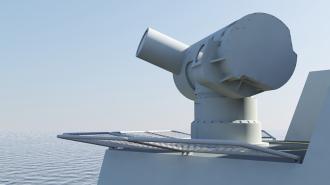The UK has successfully test-fired its first high-powered, long-range laser weapon — putting its military one step closer to dramatically improving its defense against incoming threats.
“[This] is the culmination of five years worth of effort … To get to a position where we’ve proven that the technology is effective is fantastically exciting,” said Ben Maddison, technical partner at the UK Ministry of Defence’s Defence Science and Technology Laboratory (Dstl).
The challenge: Armies have long relied on “kinetic energy” weapons that essentially throw things — rocks, arrows, bullets, missiles, etc. — at targets. This approach has meant they needed to build and transport not only their weapons, but their ammunition, too.
Traditionally, kinetic weapons designed to do major damage have been massive — each of the UK Navy’s Sea Ceptor air defense missiles, for example, weighs 218 pounds — which puts a literal burden on the militaries wielding them.
“Our current weapon systems are large, expensive, heavy, and the logistics chain required to move them around is extraordinary,” said Maddison.
“We’re able to engage the targets at the speed of light.”
Cale Hughes
The idea: Laser weapons are starting to disrupt this paradigm. By focusing light in a precise way, these devices can produce a beam capable of destroying a target just like a traditional kinetic energy weapon, but without the need for physical ammunition.
This cuts costs, simplifies logistics, and eliminates the possibility of running out of ammo — as long as the laser weapon has its power source, it can continue firing.
Because laser weapons operate at the speed of light, they’re also particularly appealing for defensive operation.
“We don’t worry about wind. We don’t worry about range. We don’t worry about anything else.”
Cale Hughe
If a military wants to neutralize an incoming missile with a kinetic weapon, it has to factor in the speed and trajectory of the missile, the speed of their ammo, environmental factors, and more — a highly complex problem to solve again and again on the fly.
But that’s not the case with laser weapons.
“We don’t worry about wind. We don’t worry about range. We don’t worry about anything else,” Cale Hughes, a laser weapons system officer in the US Navy, told CNN in 2017. “We’re able to engage the targets at the speed of light.”
While it costs a lot to build, the operating cost of that laser weapon is possibly the only thing more impressive than its speed — according to Hughes, each shot costs about $1.
What’s new? In 2017, the UK’s Ministry of Defence announced plans to build its first high-powered, long-range laser weapon, called “DragonFire,” to defend its military against missiles and drones.
On November 8, 2022, it revealed that the $115 million laser weapon had been fired at high power at targets, including a drone and metals like the ones used in ship hulls, at ranges up to 2.1 miles.
This followed a low-power trial in July, during which DragonFire’s tracking systems were put to the test.
“This trial is the culmination of design, development, and demonstration activity over a number of years … the outcome shows that the UK has world-leading capability in the technologies associated with laser directed energy weapons systems,” said Maddison.
Looking ahead: DragonFire’s exact capabilities are classified, and the UK hasn’t said when it anticipates the laser weapon being ready for deployment, but according to MBDA, the missile company leading DragonFire’s development, it might not be long.
“The results from these trials have verified analysis and given the team confidence that DragonFire will offer a near term and unique capability,” said Chris Allam, managing director of MBDA UK.
We’d love to hear from you! If you have a comment about this article or if you have a tip for a future Freethink story, please email us at [email protected].





